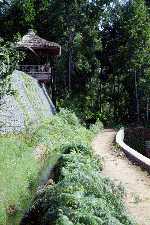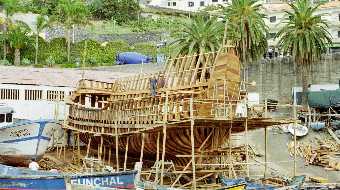
Madeira has much to offer. The climate is pleasant all the
year and although there may sometimes be rain in the winter there has always
been sunshine. It is not a beach holiday since being a volcanic island there is
little sand. Accordingly there are few children amongst the tourists and the
majority of clients are probably retired. The nearby island, Ilha de Porto
Santo, has beaches and is but a boat trip away. Funchal has many amenities and
an air of safety - provided you look left when crossing the road. Buses are
frequent and we bought a season ticket for 2.20 euros. It was recharged for 0.85
euros per trip at the bus terminus downtown on the way to the cable car, or
opposite the Miramar hotel. The ticket is valid for all trips around Funchal and
for many of the routes up to the levadas.
Swimming pools at the hotels tend to be artistic and shaped
more for appearance than serious swimming. We like bathing in the seawater
swimming pools rather than chlorinated fresh water. One pool is usually heated
in the winter; the others although rather chilly are also swimmable, as indeed
is the sea if you are hardy - from steps down to a sheltered harbour.
We discovered the levada walks in a leaflet from the Jasmin
Tea House - available at the tourist office. We followed the instructions to
take a 29 or 77 bus to Camacha. Ten minutes later we were walking alongside the
stream. Levadas, which are a unique feature of the island, channel water from
the hills to the houses. They are sloped just sufficiently to make the water
flow. A walk alongside on the footpath is essentially level and if you follow
the flow of water it acts as a sign post to your destination. You cannot lose
your way. It was about a two and a half-hours to the teahouse, taking into
account a stop at Joao Baptista Carreira to see his unique collection of wicker
work including wicker violins - for decoration only. We passed through forests
scented with pine, sometimes revealing a panoramic view over the city to the
harbour. The solitude is occasionally broken by the appearance of fellow walkers
of all nationalities and a cheery greeting reflecting the shared experience.
Our only mishap occurred at the tunnel. The instructions were "under
no circumstances attempt the tunnel without a torch". So we scrambled up a
muddy slippery slope to the road, which we followed while looking for a way back
to the levada. Eventually we had to strike across country and climb a hill of
straw compost to find the footpath. This led to the Jasmin teahouse and a choice
of innumerable varieties of tea with a home made scone. (In a subsequent year we
armed ourselves with torches and boots and ventured through the tunnel. The path
inside is narrow and the roof slopes over the walker so that a tall person has
to crouch slightly. Occasionally there is a wider part to allow people to pass
from the other direction.) A bus timetable is available at the teahouse and from
the nearby stop a 47 bus runs you back to Funchal town centre.
For our second walk we took the 29 bus to Curral dos Romeiros
terminus. This easier walk is only an hour and a half. On the way it passes the
Hortensia teahouse which is set back in gardens alongside the levada. There are
many other levada walks of varying difficulty. Some are dangerous and a guide is
recommended.
We took the cable car from Funchal to Monte village, a short
distance from the Monte Palace Tropical Garden at Caminho das Babosas. A new
cable car has been completed to provide a round trip to the Botanical gardens
with panoramic views of Funchal bay. On the way we chanced on the Monte toboggan
ride. Said to date from the 1850's the toboggan is controlled by two men who
provide the motive power and rubber soled boots for braking. Two young ladies
were sitting in the wicker chairs mounted on a wooden sledge as it slid over the
cobbles. It is claimed they can reach 48 Kms/hour and you are back in Funchal in
10 minutes.
We had seen the replica of the Santa Maria de Columbo being
built in Camara de Lobos in 1997. Made of mahogany, it has a robust appearance,
is 22 meters long and accommodates about 100 people. It sails twice a day from
the harbour at Funchal to village.
Our visit to Blandy's Wine lodge in Funchal was a trip back to
a previous century. Many varieties of Madeira wine ranging through dry, medium
dry, medium rich and rich can be purchased. Seating is on upturned wine barrels in
a heavily beamed chamber. 3, 5 or 10 years vintages are offered. Older wines
are at a premium and offered in adjacent premises. From there it is a short walk
to the cafes to watch the world go by over a cup of coffee, hot chocolate or a
cooling beer.
It is a destination for many cruise ships, some on their way
to the Americas, others on shorter cruises from the Mediterranean. |



